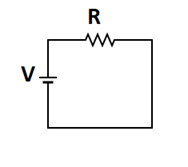Ohm’s Law:
![]()
Where:
V = voltage (Volts, V)
I = current (Amperes, Amps, A)
R = resistance (Ohms, Ω)
Electrical Current is the flow of charge over time.
1 Amp = 1 Coulomb / second.
(Coulomb is a unit of electrical charge.)
Current is positive current, so it’s defined as backwards from the direction of the flow of negative electrons.
Voltage is the amount of energy behind each charge. Voltage causes current to flow.
Voltage and current are proportional to each other: twice as much voltage causes twice as much current flow.
1 V = 1 Joule / Coulomb.
(Joule is a unit of energy and Coulomb is a unit of charge)
Electrical Resistance means resistance to electrical current flow. In other worse, more resistance causes less current.
Current is inversely proportional to resistance: doubling the resistance causes current to be cut in half.
1 Ohm = 1 V / A
Here’s a better way to look at Ohm’s Law. This shows how current is proportional to voltage and inversely proportional to resistance:
![]()
Simple Circuits
A simple circuit has exactly one resistor and one voltage source.
(By contrast, series and parallel and combination circuits have more than one resistor)
The diagram below shows a schematic circuit diagram.
The two line symbol is a Voltage Source (usually a battery or a DC voltage source box that plugs into a wall outlet).
The zig-zag symbol is a resistor. A real life resistor could be a small electrical component that is more difficult for electricity to flow through than a wire. It could also represent something like a light bulb or a motor that also causes electrical resistance.
